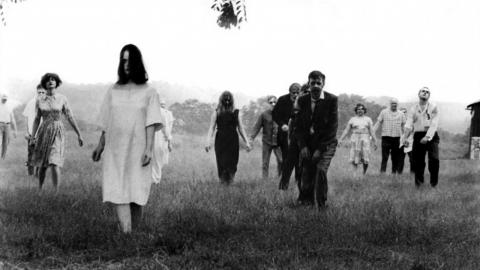They're Coming to Get You: NIGHT OF THE LIVING DEAD

NIGHT OF THE LIVING DEAD
These notes on George A. Romero's Night of the Living Dead were written by Lillian Holman, PhD candidate in UW Madison’s Department of Communication Arts. A newly restored DCP, personally supervised by Romero, will screen as part of a tribute to the late director on Saturday, November 18 at 7 p.m. in our regular venue, 4070 Vilas Hall.
By Lillian Holman
On its surface there is nothing scary about a middle aged man staggering slowly through a cemetery. He is not grotesque and he is wearing a suit; he is the prime example of unassuming. Yet this man is the first big scare of Night of the Living Dead (1968), one of the forerunners of decades of zombie movies made in its image. You’ll forget how harmless said man appeared when he is banging on your car door, blank-faced, and determined to kill you. The late George Romero directed Dead and it is his incredible power of taking the unassuming and making it terrifying that makes Dead iconic. Much like B-level horror movies from the studio era, Romero makes use of a low budget to generate horror from the unexpected and tension from the cinematic.
Most of the plot takes place in one house during one night, as Ben, played by Duane Jones, shelters in place and works to protect himself and the rest of the house’s occupants against the oncoming swarm of the mysterious undead. As the night wears on, Ben and the group (a young woman named Barbara, a family called the Coopers and a teenage couple named Tom and Judy) try to survive and also piece together what on earth is happening through snippets on the radio and TV. The threat of the dead is always there as the zombies linger outside waiting either for the humans to slip up or their numbers to grow strong enough to break through. This ticking time bomb frightens us as much as the zombies themselves. Ben is remarkably competent, but the implications are that he will have to maintain perfection in order to survive the night. Therefore, his competence is a double-edged sword. We can have more faith that he will make it, but we can take no comfort in potentially knowing more than he does. Romero doesn’t give us privileged information and Ben seems to anticipate anything we would. We are forced to fear the unexpected, therefore, and wonder at what window Ben is going to miss or what loophole the dead are going to find. If we were the ones in Ben’s place, there is little chance we could do better than he does and it is all the more likely we would end up like Barbara.
The horror does not just lie in the oncoming dead, however. Jason Zinoman of the New York Times wrote in a reflection about George Romero, that “Romero will always be known for turning hordes of dead people into a new kind of mainstream monster, but what made him a revolutionary artist is that he didn’t let the living off the hook.” As Ben works tirelessly to board up the house, he has to balance his fear of the zombies with the terrifying incompetence of the shell-shocked Barbara and the actively unhelpful blowhard, Harry Cooper. Barbara was our red-herring protagonist, who lives on in the film as mute reminder of our own fear and helplessness. She follows Ben in a catatonic state and even though she is technically another living adult, she must be protected like a child. Cooper, meanwhile, is a different kind of problem. His ego and his selfishness is as life-threatening as the zombies themselves. He is confident that he knows best and refuses to listen to Ben’s sound logic. He also continues to choose what will save his family over what will save the group. While not heavy-handed, the fact that it is 1968 and a middle aged white man is refusing to listen to or care about a young black man is not insignificant. Neither Cooper nor Ben references the color of Ben’s skin, but the implied racism is there. According to Matt Thompson of NPR’s Code Switch, who in turn cites Joe Kane, “Ben was not originally envisioned as a black character. But the casting of Duane Jones in the role gave it a societal resonance that later zombie fiction would strive to recreate.” This is present in Ben’s relationship with Cooper, but becomes even more tragic and impactful during the iconic ending that is not worth spoiling here, but maintains chilling relevance to this day.
In his obituary for Romero, director Edgar Wright remarks that “‘Romero’, immediately conjures more images and themes than 99 percent of writer/directors out there.” Night of the Living Dead was the first conjuring of those images and themes and it is remarkably prescient to this day. As the dead walk across our movie and TV screens, it was Romero who released them and warned us with the ever chilling “They’re coming to get you, Barbara…” Get us they did and oddly enough, we are grateful.
